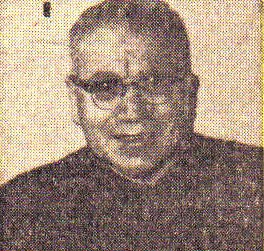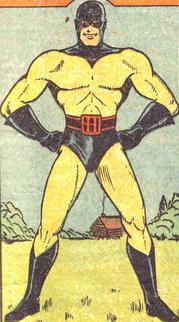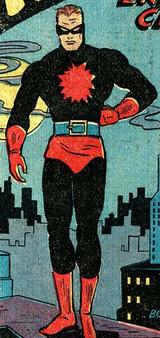
Archie Comic Publications, Inc., is an American comic book publisher headquartered in Pelham, New York. The company's many titles feature the fictional teenagers Archie Andrews, Jughead Jones, Betty Cooper, Veronica Lodge, Reggie Mantle, Sabrina Spellman, Josie and the Pussycats and Katy Keene. The company is also known for its long-running Sonic the Hedgehog comic series, which it published from 1992 until 2016.

The Fly is a superhero appearing in American comic books published by Red Circle Comics. He was created by Joe Simon as part of Archie's "Archie Adventure Series" and later camped up as part of the company's Mighty Comics line. He first appeared in The Double Life of Private Strong #1 ; however, his origin story and first "full-length" appearance were in Adventures of the Fly #1.

Dark Circle Comics is an imprint of Archie Comics Publications, Inc. Under its previous name, Red Circle Comics, it published non-humor characters, particularly superheroes in the 1970s and 1980s.

The Shield is the name of several superheroes created by MLJ. Appearing months before Captain America, the Shield has the distinction of being the first superhero with a costume based upon United States patriotic iconography. The character appeared in Pep Comics from issue #1 to #65.

Paul J. Reinman was an American comic book artist best known as one of Jack Kirby's frequent inkers during the period comics fans and historians call the Silver Age of Comic Books. This included the first issues of The Incredible Hulk and The X-Men.
Thunderbunny is a comic book about a boy who transforms into a superhero resembling a large pink humanoid rabbit. It was created by Martin L. Greim.

The Black Hood is the name of several fictional characters created by MLJ Comics during the period known as the "Golden Age of Comic Books". The Black Hood first appeared in Top-Notch Comics #9, October 1940 and became one of MLJ's most popular characters. He has been in four self-titled series as well as in his own radio show, Black Hood (1943–1944). In recent decades, the Black Hood has been sporadically licensed and published by DC Comics. However, the character reappeared under Archie Comics' Dark Circle Comics line in 2015.

Pep Comics is an American comic book anthology series published by the Archie Comics predecessor MLJ Magazines Inc. during the 1930s and 1940s period known as the Golden Age of Comic Books. The title continued under the Archie Comics imprint for a total of 411 issues until March 1987.

The Comet is a character that first appeared in Pep Comics #1 in January 1940. A little over a year later, the Comet was the first superhero to be killed in the line of duty. He died in issue #17, which also introduced his brother, a brutal hero called the Hangman.

The Fox is the name of two superheroes that appear in periodicals published by MLJ Comics and later Dark Circle Comics.
The Web is a superhero created by MLJ Comics in 1942 by artist John Cassone and an unknown writer. The character was published in Zip Comics until 1943, and was later brought back in 1966 to appear in Archie's revived superhero line. DC Comics licensed Archie's superhero characters in 1991, and brought a new revival of the character to life in 2009.

Blue Ribbon Comics is the name of two American comic book anthology series, the first published by the Archie Comics predecessor MLJ Magazines Inc., commonly known as MLJ Comics, from 1939 to 1942, during the Golden Age of Comic Books. The revival was the second comic published in the 1980s by Archie Comics under the Red Circle and Archie Adventure Series banners.

Magazine Enterprises was an American comic book company lasting from 1943 to 1958, which published primarily Western, humor, crime, adventure, and children's comics, with virtually no superheroes. It was founded by Vin Sullivan, an editor at Columbia Comics and before that the editor at National Allied Publications, the future DC Comics.

Firefly is a superhero created by Harry Shorten and Bob Wood for MLJ Comics in 1940. He first appeared in Top-Notch Comics #8. Artist Warren King and writer Joe Blair loaned their talents to many of the Firefly's installments.
The Wizard is a superhero created by Will Harr and Edd Ashe Jr. for MLJ Comics, which later became Archie Comics. He first appeared in Top-Notch Comics #1 in December 1939, and he was one of the headliners of that title until its cancellation in 1944. He was one of the earliest superhero characters to appear after the debut of Superman in 1938.

The Hangman is the name of several fictional superheroes that appear in periodicals published by MLJ Comics and later Dark Circle Comics.

Hangman Comics was the name of an American anthology comic book series published by MLJ Magazines Inc., more commonly known as MLJ Comics, for seven issues between Spring 1942 and Fall 1943. It featured MLJs costumed vigilante The Hangman, and "Boy Buddies", featuring Shield's partner 'Dusty the Boy Detective' and Wizard's side-kick 'Roy the Superboy', throughout the series.

Impact Comics was an imprint of DC Comics that was aimed at younger audiences. It began in 1991 and ended in 1993. The initial "I" in the logo was stylized as an exclamation point, but the official name of the imprint was not !mpact.

The New Crusaders is a fictional superhero team and their eponymous title published by Archie Comics' imprint Red Circle Comics. A revamp of the previously published Mighty Crusaders title, New Crusaders follows the sons and daughters of the original Mighty Crusaders as they acquire their own powers and attempt to become superheroes. The series was written by regular Sonic the Hedgehog writer Ian Flynn and ended on a cliffhanger.
















